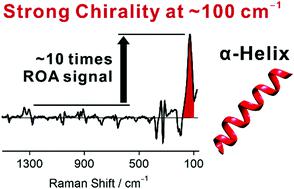当前位置:
X-MOL 学术
›
Phys. Chem. Chem. Phys.
›
论文详情
Our official English website, www.x-mol.net, welcomes your
feedback! (Note: you will need to create a separate account there.)
Intense chiral signal from α-helical poly-L-alanine observed in low-frequency Raman optical activity
Physical Chemistry Chemical Physics ( IF 2.9 ) Pub Date : 2021-11-22 , DOI: 10.1039/d1cp04401j Shigeki Yamamoto 1 , Shota Ishiro 1 , Jiří Kessler 2 , Petr Bouř 2
Physical Chemistry Chemical Physics ( IF 2.9 ) Pub Date : 2021-11-22 , DOI: 10.1039/d1cp04401j Shigeki Yamamoto 1 , Shota Ishiro 1 , Jiří Kessler 2 , Petr Bouř 2
Affiliation

|
Raman optical activity (ROA) spectral features reliably indicate the structure of peptides and proteins, but the signal is often weak. However, we observed significantly enhanced low-frequency bands for α-helical poly-L-alanine (PLA) in solution. The biggest ROA signal at ∼100 cm−1 is about 10 times stronger than higher-frequency bands described previously, which facilitates the detection. The low-frequency bands of PLA were compared to those of α-helical proteins. For PLA, density functional simulations well reproduced the experimental spectra and revealed that about 12 alanine residues within two turns of the α-helix generate the strong ROA band. Averaging based on molecular dynamics (MD) provided an even more realistic spectrum compared to the static model. The low-frequency bands could be largely related to a collective motion of the α-helical backbone, partially modulated by the solvent. Helical and intermolecular vibrational coordinates have been introduced and the helical unwinding modes were assigned to the strongest ROA signal at 101–128 cm−1. Further analysis indicated that the helically arranged amide and methyl groups are important for the strong chiral signal of PLA, while the local chiral centers CαH contribute in a minor way only. The strong low-frequency ROA can thus provide precious information about the motions of the peptide backbone and facilitate future protein studies.
中文翻译:

在低频拉曼光学活动中观察到来自α-螺旋聚-L-丙氨酸的强烈手性信号
拉曼光学活性 (ROA) 光谱特征可靠地指示肽和蛋白质的结构,但信号通常很弱。然而,我们观察到溶液中α-螺旋聚L-丙氨酸 (PLA)的低频带显着增强。∼100 cm -1处的最大 ROA 信号比前面描述的更高频带强约 10 倍,这有助于检测。PLA的低频带与α-螺旋蛋白的低频带进行了比较。对于 PLA,密度泛函模拟很好地再现了实验光谱,并揭示了 α-螺旋两圈内的约 12 个丙氨酸残基产生了强 ROA 带。与静态模型相比,基于分子动力学 (MD) 的平均提供了更加真实的光谱。低频带可能很大程度上与α-螺旋骨架的集体运动有关,部分受溶剂调制。引入了螺旋和分子间振动坐标,螺旋展开模式被分配给 101-128 cm -1处的最强 ROA 信号. 进一步分析表明,螺旋排列的酰胺和甲基对 PLA 的强手性信号很重要,而局部手性中心 C α H 的贡献很小。因此,强大的低频 ROA 可以提供有关肽骨架运动的宝贵信息,并促进未来的蛋白质研究。
更新日期:2021-11-22
中文翻译:

在低频拉曼光学活动中观察到来自α-螺旋聚-L-丙氨酸的强烈手性信号
拉曼光学活性 (ROA) 光谱特征可靠地指示肽和蛋白质的结构,但信号通常很弱。然而,我们观察到溶液中α-螺旋聚L-丙氨酸 (PLA)的低频带显着增强。∼100 cm -1处的最大 ROA 信号比前面描述的更高频带强约 10 倍,这有助于检测。PLA的低频带与α-螺旋蛋白的低频带进行了比较。对于 PLA,密度泛函模拟很好地再现了实验光谱,并揭示了 α-螺旋两圈内的约 12 个丙氨酸残基产生了强 ROA 带。与静态模型相比,基于分子动力学 (MD) 的平均提供了更加真实的光谱。低频带可能很大程度上与α-螺旋骨架的集体运动有关,部分受溶剂调制。引入了螺旋和分子间振动坐标,螺旋展开模式被分配给 101-128 cm -1处的最强 ROA 信号. 进一步分析表明,螺旋排列的酰胺和甲基对 PLA 的强手性信号很重要,而局部手性中心 C α H 的贡献很小。因此,强大的低频 ROA 可以提供有关肽骨架运动的宝贵信息,并促进未来的蛋白质研究。











































 京公网安备 11010802027423号
京公网安备 11010802027423号